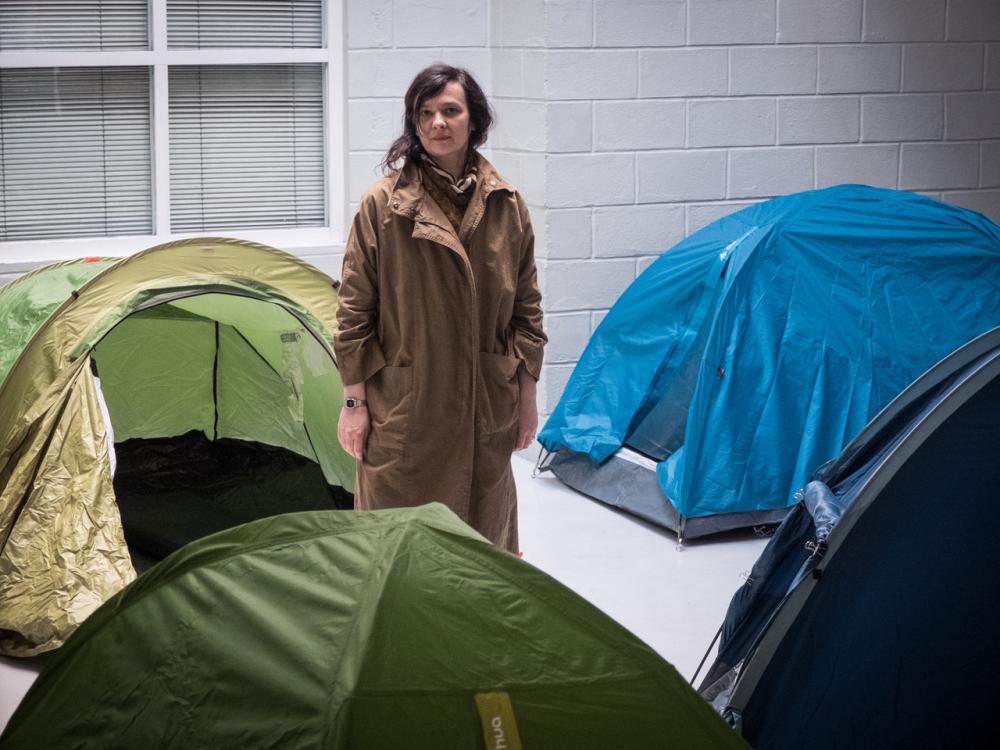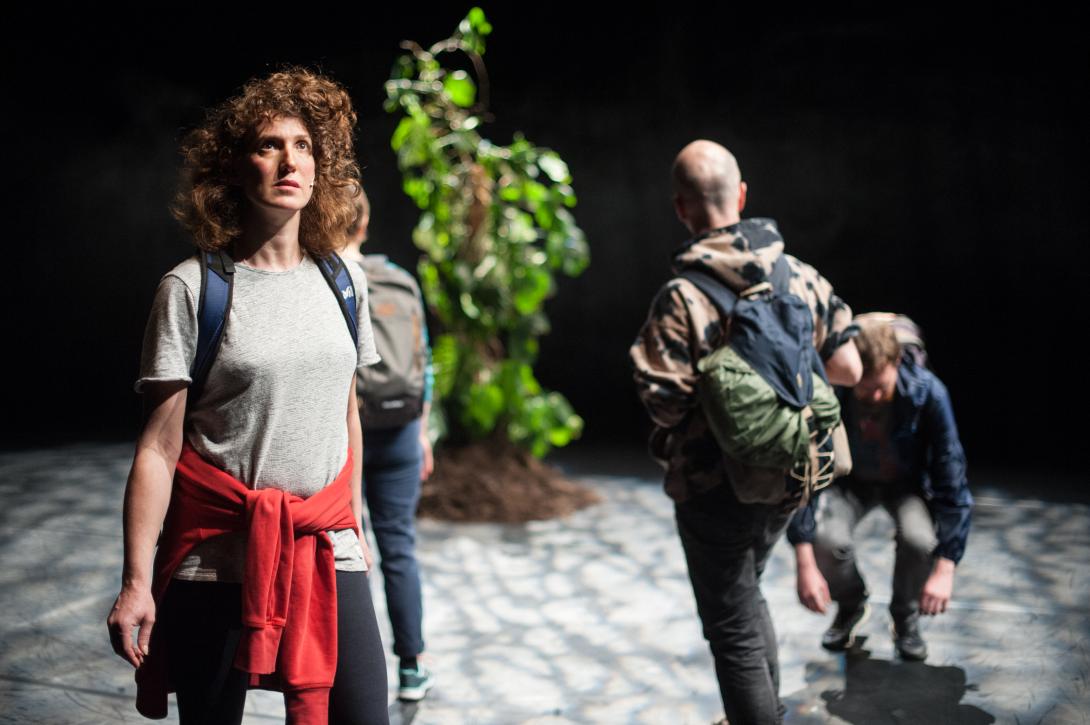‘Not constantly to do, just to be’
A conversation with Ivana Müller
A conversation with Ivana Müller, by Guy Gypens & Eva Decaesstecker (Kaaitheater)
The stage is empty, except for a potted plant. As time progresses decelerated, the stage grows into an imaginary landscape full of plants, rocks, and water. Four wandering travellers penetrate further into the forest and lose their way completely. In Conversation out of place, choreographer Ivana Müller continues her exploration of new ways of dealing with time and imagination. ‘The attempt to collectively slow down time is the most political part of the piece.’
Could you tell us about the different ideas that shape Conversations out of place?
As a choreographer, I have been exploring different relationships between the idea of the body, the common, and the place of the imagination. I have spent the past six years working on scripted dialogues – scripted conversations – so the form of a conversation immediately came to mind as well. What I find interesting in a conversation is that there is no final goal, no programme to follow: it is a series of exchanges, detours, encounters, and associations. S
Over the past few years, I have also become interested in using ideas of exchange and ecology as a frame: how do we invest ourselves in being together? How do we exchange thoughts and ideas? How can we recycle in a good and interesting way? How do we work on the idea of sustainability as a practice but also as an approach to choreography, dramaturgy, etc.? These reflections were the basis for the creation of Conversations out of place.
How did you build these ecologic strategies into the piece?
I recycled an element of each of my previous pieces. While we were holding it together (2006), for example, is a tableau vivant. In Conversations everything is based on a repetition or transformation of one tableau that is always coming back. Playing Ensemble Again and Again (2008) is a piece that is entirely performed in slow motion. Or in 60 minutes of opportunism (2010), for example, I use a backpack and all the elements in the show come out of this backpack.
The structure of Conversations is cyclical – as the same kind of images recur throughout the piece – and linear at the same time (it has a beginning, a middle and an end). The fact that the iterating images get transformed with the experience of watching could be seen as a way of dealing with recycling as well. This re-appropriating aspect creates potential for sustainable dramaturgical development. The piece starts with nothing on stage, except for one plant. Elements accumulate on stage throughout the piece. They might look like waste at first, but once they have been re-used as visual and textual elements of the piece, they start to trigger the imagination. There again we might be dealing with the idea of recreation or recycling.
You mentioned the plant already. Nature and our relationship with nature plays a significant role in Conversations out of place. Why did you decide to go for just one plant on stage?
When I started working on the piece, I realized that concretely, theatre is one of the most un-ecological places you can think of. Just imagine the kilowatts we use to light a stage! In the beginning I wanted to work with many more plants, but then I realised how horrible that would be: plants are not very happy when you drag them onstage in the black box without light that can feed them. So I reduced the presence of ‘real nature’ to one potted plant. Being in a theatre, as a place of representation, I continued working on this idea of how to represent and collectively imagine nature.
During the creation of the performance, you had a residency at Parc De La Villette. A park illustrates the relationship between humans and nature very well. How did this residency influence the piece?
I had a lot of talks with Nicolas Boehm – the gardener at the Park de la Villette – about concepts like rooting, symbiosis, implanting, colonizing… Concepts that have an interesting echo in the socio-political context. Indeed, different types of gardens are direct translations of mentalities and reflections on how to organize our immediate surroundings. Nature then functions as material and philosophical, with social or political concepts as tools. Just take a look at the huge difference between an English, French and Japanese garden!
Paintings were another important influence in the process. In Romantic landscape paintings, there are always four elements: vegetal elements (trees, plants), mineral elements (rocks, mountains), water (a lake or river) and animals/humans. The tableau created at the end of Conversations out of place has all those elements: the representation of mountains, created with very few means, the representation of water in a very minimal yet spectacular format, plants in a very sustainable format and performers that are in permanent transformation.
The ‘conversation piece’ is another form of painting that inspired us as we worked on the piece. This type of painting was very popular in eighteenth- and nineteenth-century England. It was influenced by Dutch painting and it was mostly influenced by developments in colonies. People travelling to the colonies would bring different plants and decorative elements back with them. Wealthy people used them to create fantastical spaces, little paradises in their homes. And in the nineteenth century, you also see this obsession with fake ruins in gardens: The Follies. In the conversation pieces, all these things are part of the landscapes in which families would be portrayed. As the name of the genre suggests, you see them posing while engaging in a conversation. In the indoor version of the conversation piece, you can see the salons with plants like the one we have onstage.
What about the conversation that is taking place in your performance?
The text of the conversation is written based on a lot of improvisation and includes material that the performers Hélène Iratchet, Julien Lacroix, Anne Lenglet and Vincent Weber contributed. It is an ongoing conversation: the majority of the piece is written, but there are always possibilities to break it and start improvising, which keeps the piece very much ‘alive’. I wanted them to be engaged in a conversation and not just acting out one that took place months ago. In that sense, the performers can never “simply” wait for their cue to say a sentence, they always have to really listen to each other. It’s like a choreographic improvisation, but with words.
There is something very weird about the aspect of time in the piece: it is projected in a sort of unknown future and but also seems to take us back to a long time ago. And yet the piece is completely about the present.
There are different levels on which we treat the span of time. The first one is the pace of the performance. All the movements are performed in slow motion while the performers speak at normal speed. So there is something extremely unnatural about it. And yet it can be compared to a certain kind of meditative state. It is interesting to see how this condition opens up different possibilities of perspective or of being in the moment.
For me, this attempt to collectively slow down time is the most political part of the piece. The problems we have nowadays are provoked by the extreme acceleration of the last twenty years. You can see it in the history of dance: in the nineties, people moved a lot. Because the century was coming to a close, dance had to be fast, infectious, snappy, with dancers falling three hundred times a second. It was the end of an era in which people believed in progress. Back then, acceleration was seen as a way to give us all better lives. But it produced damage, according to the laws of mechanics: if you move a lot, you produce heath and entropy. I think all this speed, either concretely or metaphorically, has generated the situation in which we now find ourselves. And now we have to cool down again. One way to do that is to take time and reflect. Not constantly to do, but just to be.
Conversations out of place is part of our focus week on ‘The Sublime’. The romantic tableau refers directly to the 19th century idea of nature as something sublime. The way you deal with the relationship between humans and nature is actually the opposite of what the sublime was: you don’t present nature as something unknown, dangerous, and mysterious. But then again, through the pace and the conversations, something sublime comes in again: the unknown, which is related to what we do to nature.
I was not actively working on the idea of producing the sublime, but somehow it was there from the beginning of the process, mostly as something that was literally lifted from the flow of the piece – an image, a movement, a gesture or an event. There are a lot of mysterious or almost spiritual elements in the piece that can create a sense of the sublime: there are moments when the flow of movement is stopped by something the performers hear, like some kind of invisible guest who threatens from the darkness. We also talk about death in a very particular way: the disappearance of the people. The fact that we are ephemeral is both something very scary but also something very sublime, which refers to this realm of spirituality. And only if we accept or have this spiritual side can we bear this notion of disappearing. At least, that is my point of view.
All this sounds very heavy and serious, but actually there is a lot of humour in the piece too.
With Conversations out of place I wanted to create a general condition in which we spend some time together. It might seem like quite a radical one because the whole piece unfolds at this one pace, but when you look closer, you discover different speeds, impulses, and energies. And humour is indeed one of them. It helps the spectator to engage in the piece, and works as an inviting element. In all of my pieces, the text treats serious and important questions on the one hand, but there are always extremely silly and often humorous moments on the other. I mostly make work from the position of the spectator: I make sure to offer different distances and perspectives to the issue I am treating, throughout the piece. There are moments that you can connect to what you look at and listen to in a direct way – and humour often creates that connection. And then there are moments when there is more distance. When I’m a spectator, I like to be given more space and be left on my own. This piece, in that sense, offers quite a generous environment and opens the space for the spectator to get inside. It’s a space where I genuinely share the questions I asked myself, without necessarily giving the answers. And this allows for an ongoing exchange.

